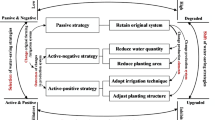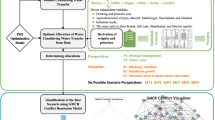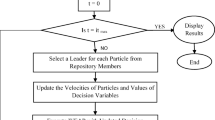Abstract
Water resources at the basin level are affected by climate change in the form of available water scarcity and multiple droughts leading to conflicts among different water users, especially between the agricultural sector and wetland services. However, owing to the multidimensional and multi-scalar nature of water management and climate change, it is needed to integrate tools to analyze impacts and adaptation. Accordingly, the current study presents an economic-hydrological-behavioral modeling to evaluate potential effects of climate change and adaptation strategies on irrigated agriculture and to manage water resources conflicts among different water users and uses in basins. This model has an iterative framework between a farm-based multi-objectives optimization model, a water evaluating and planning model (WEAP), and an agent-based model, which can represent socio-economic, hydrologic, agronomic and behavioral systems covering all dimensions and scales related to climate change. For this purpose, the economic-hydrological-behavioral modelling was applied in a case study in the Halilrud Basin in Kerman Province, Iran. Results revealed that adoption of suitable adaptive strategies and measures could mitigate the effects of climate change and provide more water to restore the Jazmourian Wetland in this basin. Additionally, the results indicated that different forms of rigidity in the individual behavior of farmers slowed down the adaptation of the agricultural sector, so that implementation of adaptive strategies led to only 14% less water consumption.







Similar content being viewed by others
References
Aghapour Sabbaghi M, Nazari M, Araghinejad S (2020) Economic impacts of climate change on water resources and agriculture in Zayandehroud river basin in Iran. Agric Wat Manage 241:106323. https://doi.org/10.1016/j.agwat.2020.106323
Agriculture-Jihad organization in south of Kerman province (2017) Data and information of agricultural units in south of Kerman province. Annualy reports
Akhbari M, Grigg NS (2013) A framework for an agent-based model to manage water resources conflicts. Wat Res Manage 27(11):4039–4052
Akhbari M, Grigg NS (2015) Managing water resources conflicts, Modelling behavior in a decision tool. Wat Res Manage 29(14):5201–5216
Akter S, Grafton RQ, Merritt WS (2014) Integrated hydro-ecological and economic modeling of environmental flows: Macquarie marshes. Australia Agric Wat Manage 145:98–109
Bandini S, Manzoni S, Vizzari G (2009) Agent-based modeling and simulation: an informatics perspective. J Artif Soc Soc Simul 12(4):4
Barkhori S, Mahdavi R, Zehtabian G, Gholami H (2018) Evaluation of the climatic variables of Jiroft Plain using HadCM3 model in future periods. J Ran Watersh Manage 71(2):355–366
Blanco-Gutierrez I, Varela-Ortega C, Purkey DR (2013) Integrated assessment of policy interventions for promoting sustainable irrigation in semi-arid environments: a hydro-economic modeling approach. J Environ Manag 128:144–160
Brown CM, Lund JR, Cai X, Reed PM, Zagona EA, Ostfeld A, Hall J, Characklis GW, Yu W, Brekke L (2015) The future of water resources systems analysis: toward a scientific framework for sustainable water management: the future of water resources systems analysis. Water Resour Res 51(8):6110–6124
D'Agostino DR, Scardigno A, Lamaddalena N, ElChami D (2014) Sensitivity analysis of coupled hydro-economic models: quantifying climate change uncertainty for decision-making. Wat Res Manage 28(12):4303–4318
Davidson NC (2014) How much wetland has the world lost? Long-term and recent trends in global wetland area. Mar Freshw Res 65:936–941
Draper D (2011) Assessment and propagation of model uncertainty. J Royal Stat Soc Series B (Methodological) 57(1):45–97
Edwards M, Ferrand N, Goreaud F, Huet S (2005) The relevance of aggregating a water consumption model cannot be disconnected from the choice of information available on the resource. Simul Model Prac Theo 13(4):287–307
Esteve P, Varela-Ortega C, Gutierrez I, Downing TE (2015) A hydro-economic model for the assessment of climate change impacts and adaptation in irrigated agriculture. Ecol Econ 120:49–58
Farhadi S, Nikoo MR, Rakhshandehroo GR, Akhbari M, Alizadeh MR (2016) An agent-based-Nash modeling framework for sustainable groundwater management: a case study. Agric Wat Manage 177:348–358
Forni LG, Medellin-Azuara J, Tansey M, Young C, Purkey D, Howitt R (2016) Integrating complex economic and hydrologic planning models: an application for drought under climate change analysis. Wat Res Econ 16:15–27
Ganoulis J, Skoulikaris H, Monget JM (2008) Involving stakeholders in transboundary water resources management, the Mesta/Nestos ‘HELP’ basin. Water SA 34(4):461–467
Gohar AA, Amer SA, Ward FA (2015) Irrigation infrastructure and water appropriation rules for food security. J Hydrol 520:85–100
Gottschalk P, Lüttger A, Huang S, Leppelt T, Wechsung F (2018) Evaluation of crop yield simulations of an eco-hydrological model at different scales for Germany. Field Crops Res 228:48–59
Hirji R, Davis R (2009) Environmental flows in water resource policies, plans and projects. The World Bank, Washington DC
IPCC (2014) Summary for policymakers. In: Field CB, Barros VR, Dokken DJ et al (eds) Climate change 2014: impacts, adaptation, and vulnerability. Part A: Global and Sectoral aspects. Cambridge University Press, Cambridge, pp 6–11
Kahil MT, Dinar A, Albiac J (2015) Modelling water scarcity and droughts for policy adaptation to climate change in arid and semiarid regions. J Hydrol 522:95–109
Li H, Yongyuan Y, De-Bin D (2015) Testing a participatory integrated assessment (PIA) approach to select climate change adaptation actions to enhance wetland sustainability: the case of Poyang Lake region in China. Adv Clim Chang Res 6:141–150
Li FP, Zhang GX, Xu YJ (2016) Assessing climate change impacts on water resources in the Songhua river basin. Water 8(10). https://doi.org/10.3390/w8100420
Liu Q, McVicar TR, Yang ZF, Donohue RJ, Liang LQ, Yang YT (2016) The hydrological effects of varying vegetation characteristics in a temperate water limited basin: development of the dynamic Budyko-Choudhury-Porporato (dBCP) model. J Hydrol 543:595–611
Mavrotas G (2009) Effective implementation of e-constraint method in multi-objective mathematical programming problems. Appl Math Comput 213:455–465
McLaughlin DL, Cohen MJ (2013) Realizing ecosystem services: wetland hydrologic function along a gradient of ecosystem condition. Ecol Appl 23(7):1619–1631
Mehrazar A, Massah Bavani AR, Gohari A, Mashal M, Rahimikhoob H (2020) Adaptation of water resources system to water scarcity and climate change in the suburb area of megacities. Wat Res Manage 34(12):3855–3877
Meng B, Liu JL, Bao K, Sun B (2019) Water fluxes of Nenjiang river basin with ecological network analysis: conflict and coordination between agricultural development and wetland restoration. J Clean Prod 213:933–943
Mitsch WJ, Gosselink JG (2007) Wetlands (fourth edition). Wiley and Sons, Inc, Hoboken
Nikouei A, Zibaei M, Ward FA (2012) Incentives to adopt irrigation water saving measures for wetlands preservation: an integrated basin scale analysis. J Hydrol 464-465:216–232
Peck DE, Mcleod DM, Hewlett JP, Lovvorn JR (2004) Irrigation dependent wetlands versus instream flow enhancement, economics of water transfer from agriculture to wildlife uses. Environ Manag 34(6):842–855
Pourseyadi A, Kashkuli HA (2012) Studying of groundwater conditions in Jiroft basin with MODFLOW. Irr Sci Engin 35(2):51–63
Qureshi ME, Ranjan R, Qureshi SE (2010) An empirical assessment of the value of irrigation water: the case study of Murrumbidgee catchment. Austra J Agric Res Econ 54(1):99–118
Ramsar Convention on Wetlands, FAO, International Water Management Institute (2014) Wetlands and agriculture: Partners for growth. https://www.ramsar.org/sites/default/files/wwd14_leaflet_en.pdf. Accessed 19 Jan 2018
Reeves HW, Zelner ML (2010) Linking MODFLOW with an agent-based model to support decision making. Groundw J 48:649–660
Regional Water Company of Kerman Province (2017) Water resources basic studies office, update studies of water resources balance of Jazmourian basin (First edition), Kerman, Iran
Reidsma P, Ewert F, Lansink AO, Leemans R (2010) Adaptation to climate change and climate variability in European agriculture: the importance of farm level responses. Euro J Agro 32:91–102
Ringler C, Cai X (2006) Valuing fisheries and wetlands using integrated economic-hydrologic modeling Mekong River basin. J Water Resour Plan Manage 132(6):480–487
Sahoo S, Dhar A, Debsarkar A, Pradhan B (2020) Future water use planning by water evaluation and planning system model. Wat Res Manage. https://doi.org/10.1007/s11269-020-02680-8
Salman D, Amer SA, Ward F (2017) Protecting food security when facing uncertain climate: opportunities for afghan communities. J Hydrol 554:200–215
Sieber J, Purkey D (2011) WEAP, water evaluation and planning system. User Guide, Stockholm Environment Institute, U.S. Center, Somerville, USA
Sisto NP (2009) Environmental flows for rivers and economic compensation for irrigators. J Environ Manag 90(2):1236–1240
Sunde MG, He HS, Hubbart JA, Urban MA (2018) An integrated modeling approach for estimating hydrologic responses to future urbanization and climate changes in a mixed-use midwestern. J Environ Manage 220:149–162
Tanaka SK, Zhu T, Lund JR, Howitt RE, Jenkins MW, Pulido MA, Tauber M, Ritzema RS, Ferreira IC (2006) Climate warming and water management adaptation for California. Clim Chang 76:361–387
Verhoeven JTA, Setter TL (2010) Agricultural use of wetlands: opportunities and limitations. Ann Bot 105:155–163
Westerhoff L, Smit B (2008) The rains are disappointing us: dynamic vulnerability and adaptation to multiple stressors in the Afram Plains. Ghana Mitig Adapt Stra Glob Chang 14:317–337
Wood A, van Halsema GE (2008) Scoping agriculture-wetland interactions: towards a sustainable multiple-response strategy. FAO. Water report 33. FAO, Rome, Italy
Yates D, Sieber J, Purkey D, Huber-Lee A (2005) WEAP21 - a demand-, priority-, and preference-driven water planning model. Part 1: model characteristics. Wat Inter 30(4):487–500
Yilmaz B, Harmancioglu NB (2010) Multi-criteria decision making for water resource management, a case study of the Gediz River basin. Turkey Wat SA 36(5):568–574
Yu X, Mingju E, Sun M, Xue ZH, Lu X, Jiang M, Zou Y (2018) Wetland recreational agriculture: balancing wetland conservation and agro-development. Environ Sci Pol 87:11–17
Zhang F, Zhang C, Yan Z, Guo S, Wang Y, Guo P (2018) An interval nonlinear multi objective programming model with fuzzy interval credibility constraint for crop monthly water allocation. Agric Wat Manage 209:123–133
Acknowledgments
The authors are grateful for the financial and official support provided by Shiraz University (Iran). The authors extend thanks to an anonymous reviewer for insights that would have otherwise been missed.
Author information
Authors and Affiliations
Corresponding author
Ethics declarations
Conflict of Interest
The authors have no conflicts of interest to declare.
Additional information
Publisher’s Note
Springer Nature remains neutral with regard to jurisdictional claims in published maps and institutional affiliations.
Rights and permissions
About this article
Cite this article
Mirzaei, A., Zibaei, M. Water Conflict Management between Agriculture and Wetland under Climate Change: Application of Economic-Hydrological-Behavioral Modelling. Water Resour Manage 35, 1–21 (2021). https://doi.org/10.1007/s11269-020-02703-4
Received:
Accepted:
Published:
Issue Date:
DOI: https://doi.org/10.1007/s11269-020-02703-4




